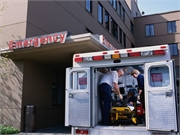WEDNESDAY, June 17, 2020 (HealthDay News) — A ruptured appendix is one medical emergency that a general surgeon colleague of Dr. Jacqueline Fincher hadn’t treated for more than 15 years in their small town of Thomson, Ga.
That’s because the signs and symptoms of appendicitis are so well-known that nearly everyone gets to the hospital well before an inflamed appendix has a chance to burst.
But then came COVID-19.
“In the month of March he had two,” said Fincher, president of the American College of Physicians. “It’s because people were afraid to go to the doctor or go to the emergency room. They sat at home and got really, really sick, and ended up going to the emergency room and having a much more difficult course.”
Even though the United States is emerging from lockdown, Americans worry that many folks remain too fearful of contracting COVID-19 to get the medical care they need to prevent a serious illness from becoming a medical emergency.
More than half the participants in a recent poll (54%) said they are concerned that their health or the health of a loved one is at risk because they’ve delayed treatment for medical problems, researchers at Fairleigh Dickinson University in New Jersey found.
Further, more than a quarter (27%) said they will not go to a doctor’s office except for emergencies, until either a vaccine or a treatment for COVID-19 is available.
“If individuals are not seeking medical care when they should, it may mean that they’re missing vaccinations. It means that perhaps they have a condition that’s going untreated, or perhaps they need an adjustment to their medications,” said Julie Kalabalik-Hoganson, chair of pharmacy practice with Fairleigh Dickinson’s School of Pharmacy and Health Sciences in Florham Park, N.J. “It has a lot of implications that we’re worried about.”
There’s no doubt the pandemic caused a serious financial hit to doctors’ offices.
In April, use of health care services declined by 68%, with a 48% reduction in revenue compared to the same time the previous year, according to a new report from FAIR Health, a nonprofit group that examines health sector economics.
For many doctors, telehealth provided a much-needed financial lifeline, the FAIR Health report says.
Fincher agreed, noting the pandemic response caused a loosening of regulatory restrictions around telemedicine and prompted many insurers to pay the same rates for a telehealth visit as they would for a regular office visit.
“It was an absolute lifesaver,” Fincher said. “Wow, it opened up. Everybody was on telehealth really fast.”
About a quarter of people in the Fairleigh Dickinson poll said they’d used online video conferencing to see a doctor or health professional since the pandemic began, and nearly three-quarters said the experience was the same or better than an in-person medical visit.
Telehealth likely helped the wellness of many locked-down people dealing with chronic medical conditions like high blood pressure, emphysema and diabetes, Fincher said.
Doctors have kept tabs on people’s health by having them regularly check their own markers, using home versions of the devices used by medical experts, Fincher said.
Folks these days use glucometers to check their blood sugar, thermometers, pulse oximeters to measure the oxygen in their body and other devices on a regular basis at home, then transmit their numbers to their doc.
“A blood pressure monitor and a scale go a long way in helping us to monitor your health and follow you outside of the office,” Fincher said. “Those devices are very helpful for us as physicians to monitor key things that keep you out of the hospital, keep you out of the emergency room. We can delay to some degree your chronic medical visit during this strange time of pandemic.”
However, it’s hard for telemedicine to capture everything a doctor can observe in person, said Dr. Gary LeRoy, president of the American Academy of Family Physicians.
“I start my examination and my assessment of my patients from the moment I see them walk into my office,” watching how they move, how they sit, how they’re dressed and how alert they appear to be, said LeRoy, a family physician in Dayton, Ohio. “Sometimes that’s my first tip that something just isn’t right with their situation.”
The reopening of America has led to a bit of a rush to the doctor’s office, he said.
“Our patients are anxiously wanting to come back in person versus on a video screen or by telephone,” LeRoy said. “My personal practice has totally flipped, in the sense that the overwhelming majority of my patient visits now are in person.”
But there remain many who are simply too fearful of COVID-19 to go have their health concerns addressed. The new poll jibes with a Kaiser Family Foundation health poll from May, in which about half of adults said either they or a family member had postponed or skipped medical care due to the pandemic.
Doctors need to keep promoting the precautions they’ve taken to prevent COVID-19 transmission in their offices, Fincher said.
For example, Fincher’s practice holds an acute respiratory illness clinic every afternoon, out of a tent behind the office. People with COVID-19 symptoms can be treated without setting foot inside the office.
“We do all the history-taking over the phone with them while they’re sitting in our parking lot, then we bring them out under the tent and examine them,” Fincher said.
Masks are required in offices, and every exam room is thoroughly cleaned between patients.
Some patients are reluctant. “I’ll ask them, ‘Well, are you going to the grocery store?'” Fincher said. “Most of the time they say yes and I tell them, ‘Well, I can promise you my office is way safer than the grocery store.'”
More information
The U.S. Centers for Disease Control and Prevention has more about COVID-19.
Copyright © 2025 HealthDay. All rights reserved.

